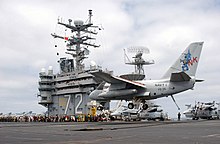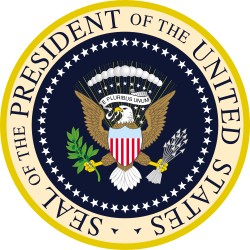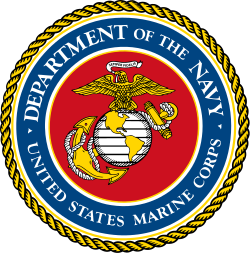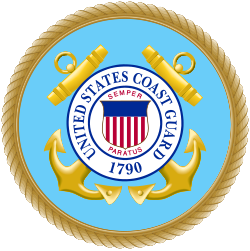Navy One

Navy One ist das Funkrufzeichen, das jedes Luftfahrzeug der United States Navy zugeteilt bekommt, sobald sich der Präsident der Vereinigten Staaten an Bord befindet.[1]
Die erste Gelegenheit, zu der Navy One existierte, war am 1. Mai 2003, als George W. Bush in einer Lockheed S-3 Viking auf den Flugzeugträger USS Abraham Lincoln (CVN-72) übersetzte, wo er seine Mission-Accomplished-Rede hielt, in der er das Ende des Irakkrieges verkündete. Diese spezielle Maschine steht heute im National Museum of Naval Aviation auf der Naval Air Station Pensacola in Pensacola, Florida.[2]
Ein Navy-Luftfahrzeug, in dem sich der Vizepräsident befindet, heißt Navy Two.
Weblinks
Einzelnachweise
- ↑ faa.gov (PDF; 2,9 MB) abgerufen am 17. November 2016
- ↑ A Visual History of Air Force One. In: Popular Mechanics. 25. Mai 2016 (popularmechanics.com).
Auf dieser Seite verwendete Medien
U.S. Department of The Army Emblem.
- In the center is a Roman cuirass below a vertical unsheathed sword, point up, the pommel resting on the neck opening of the cuirass and a Phrygian cap supported on the sword point, all between on the right an esponton and on the left a musket with fixed bayonet crossed in saltire behind the cuirass and passing under the sword guard.
- To the right of the cuirass and esponton is a flag of unidentified designs with cords and tassels, on a flagstaff with spearhead, above a cannon barrel, the muzzle end slanting upward behind the cuirass, in front of the drum, with two drumsticks and the fly end of the flag draped over the drumhead; below, but partly in front of the cannon barrel, is a pile of three cannon balls.
- To the left of the cuirass and musket is a national color of the Revolutionary War period, with cords and tassels, on a flagstaff with spearhead, similarly arranged above a mortar on a carriage, the mortar facing inward and in front of the lower portion of the color and obscuring the lower part of it; below the mortar are two bomb shells placed side by side.
- Centered above the Phrygian cap is a rattlesnake holding in its mouth a scroll inscribed "This We'll Defend."
- Centered below the cuirass are the Roman numerals "MDCCLXXVIII."
- For differences between this text description and the emblem shown above, see "Army Seal vs. Army Emblem", below.
Seal of United States Department of the Air Force - military department for the United States Air Force and the United States Space Force
Seal of the United States Marine Corps. It is defined in Executive Order 10538 (alternate source) as:
For more information, see here.Standing upon the western hemisphere of the terrestrial globe containing the lines of latitude and topographical outlines of North, Central, and South America, an American bald eagle with wings displayed horizontally and inverted holding in his beak a scroll inscribed with the motto SEMPER FIDELIS, all bronze. Behind the western hemisphere a foul anchor bend sinister-wise with stock, arms, and flukes in slight perspective, all bronze, on a scarlet background and within a dark blue band edged in gold circumscribed by a gold rope rim and inscribed DEPARTMENT OF THE NAVY • UNITED STATES MARINE CORPS in gold letters. The central device of the seal is the emblem of the United States Marine Corps.
"Navy 1", a U.S. Navy Lockheed S-3B Viking (BuNo 159387) from sea control squadron VS-35 Blue Wolves lands aboard the aircraft carrier USS Abraham Lincoln (CVN-72) on 1 May 2003. The aircraft was carrying the U.S. president George W. Bush who was the first U.S. president land on an aircraft carrier in an airplane making an arrested landing. All other presidents (including Mr. Bush) had used a helicopter. The S-3B 159387 is today preserved at the U.S. Navy National Museum of Naval Aviation at Pensacola, Florida (USA).
United States Coast Guard Seal, in correct PMS colors. This emblem shall only be used in accordance with the Coast Guard Heraldry Manual, and is not to be reproduced commercially without prior approval of the U.S. Coast Guard.
*Description: On a circular background of fair sky and moderate sea with land in sinister base, a tri-mast square rigged ship under way before a fair breeze with after top-sail furled, commission pennant atop the foremast, National Ensign atop the main, and the commodore's flag atop the mizzen. In front of the ship a luce-type anchor inclined slightly bendwise with the crown resting on the land and, in front of the shank and in back of the dexter fluke, an American bald eagle rising to sinister regarding to dexter, one foot on the ground, the other resting on the anchor near the shank; all in proper colors. The whole within a blue annulet bearing the inscription "Department of the Navy" at the top and "United States of America" at the bottom, separated on each side by a mullet and within a rim in the form of a rope; inscription, rope, mullet, and edges of annulet all gold. *Background: The policy for use of the Navy seal and emblem is contained in SECNAV Instr 5030.4 and SECNAV Instr 5030.6. The seal design was approved by the President of the United States by Executive Order 10736 dated October 23, 1957. Request for use of the Navy emblem should be submitted in writing to Defense Printing Service, ATTN: DPSMO, 8725 John Kingman Rd Suite 3239, Fort Belvoir, VA 22060-6220. The telephone number is (703) 767-4218. 1879 version here: http://etc.usf.edu/clipart/54900/54985/54985_seal_navy.htm






